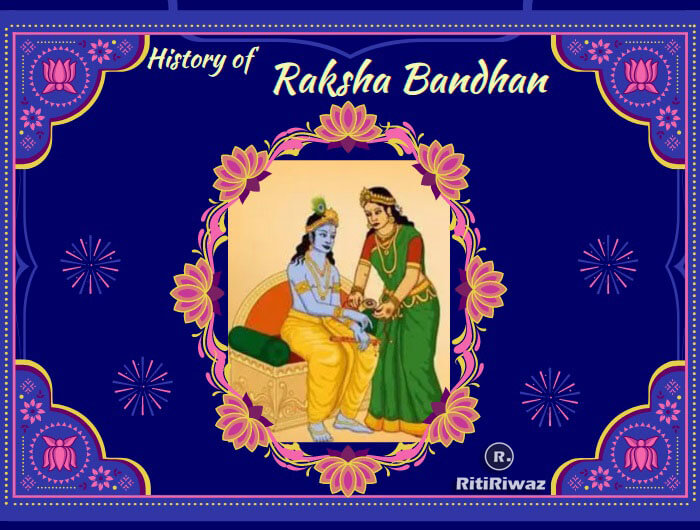The History of Raksha Bandhan

Raksha Bandhan is also known as Rakshabandhan or very simply as Rakhi, a sacred thread that sisters tie in the hands of their brother to strengthen the bond. This festival symbolizes love, care & affection among brothers & sisters, and the brother’s feeling of security towards their sisters. This is one of the most cordial and dignified of all human emotions. No matter which part of the globe you reside in, come celebrate unbroken promises with us.
The term Raksha Bandhan stands for ‘Raksha’ meaning ‘protection’ and ‘Bandhan’ meaning ‘ties or bond’. In Western India, Rakhi Purnima is also called Nariyal (coconut) Purnima. This day is observed as Shravan Purnima in Southern states of India and is especially important for the Brahmins (the priests). In Bengal, Rabindranath Tagore introduced this tradition in Shantiniketan, an institution set up by the great poet, with the aim of fostering love between people of all sects and religions.
Some of the other names for Raksha Bandhan are Vish Tarak (the destroyer of venom), Pap Nashak (destroyer of all sins), and Punya Pradayak (one that bestows boons).
Mythological stories of Rakhi
Raksha Bandhan has huge historical and mythological significance for Hindus worldwide. Rakhi dates back hundreds of years and has even been represented within many of the famous Indian mythologies. The festival is mentioned in Mahabharat, in Puranas, and other texts.
King Bali and Mata Lakshmi:
At first in Hindu mythology, Rakshabandhan can be traced in the Dwarf Incarnation (Vaman Avtar) of Lord Vishnu. When the Demon King Bali was performing a rite, Deity King Indra, being afraid of losing his empire, requested Lord Vishnu to save them.
Then Lord Vishnu incarnated as a Dwarf (Vaman) and reached the place of King Bali and asked for just a little of three steps of land. Bali was a great donor that’s why donated the same. Then Lord Vishnu measured the whole world in three steps and sent Bali to the world underground.
Bali secured a promise from Lord Vishnu for staying in front of him all the time by his devotion. Goddess Lakshmi was so troubled by this. Goddess Lakshmi went to Bali and made him her brother by tying Rakhi.
In return, she took Lord Vishnu back with her. It was the day of the full moon (Purnima) of Shravan month.
The Birth of Santoshi Maa
Ganesh had two sons, Shubh and Labh. On Raksha Bandhan, Ganesh’s sister visited and tied a Rakhi on Ganesh’s wrist. The two boys become frustrated that they have no sister to celebrate Raksha Bandhan with. They ask their father Ganesh for a sister, but to no avail.
Finally, saint Narada appears who persuades Ganesh that a daughter will enrich him as well as his sons. Ganesh agreed and created a daughter named Santoshi Maa by divine flames that emerged from Ganesh’s wives, Ruddhi (Amazing) and Siddhi (Perfection). Thereafter, Shubh Labh (literally “Holy Profit”) had a sister named Santoshi Maa (literally “Goddess of Satisfaction”), who loved and protected each other.
Rakshabandhan In Mahabharat:
Mythological traces of Rakshabandhan can also be found in Mahabharat. When Yudhishthir asked Lord Krishna, “How can I overcome all these problems?” Lord Krishna suggested him to celebrate Rakshabandhan for him and his army.
Lord Krishna’s index finger was injured while slaying Shishupal, Draupadi tore her Sari and tied a strip on his finger to stop bleeding. It was also the day of the full moon of Shravan month. Krishna in return protected her prestige while her clothes were being taken off by Dushashan in Duryodhan’s courtroom.
Rakshabandhan by Indra’s wife:
As per Indian mythology, this festival is related to the Gods and Demons fight. Indra’s wife first initiated this sort of bond of protection. She prepared a Rakhi and tied it around her husband’s wrist, to ensure that he would not only be protected from attacks by the demons but would also emerge victoriously.
Indra won this war against Demons with the help of that sacred thread. This thread is called “Raksha-sutra” or “Rakshabandhan”
Queen Karmavati send Rakhi to Mughal Emperor Humaun:
Chittaur queen Karmavati sends rakhi to Mughal Emperor Humayun. When Bahadur Shah of Gujarat attacks her, Humayun knows the value of Rakhi and honors it, he sends his army to save Queen Karmavati.
Rakhi Saved Life of Great Alexander
Alexander married Indian lady Roxana. She knows about the power of Indian King Puru. She tied Rakhi to Puru and Puru promised her to not kill her husband.
During the war between Alexander and Puru, Alexander fell down his horse. Puru has a chance to kill Alexander but he remembers the promise to his sister Roxana (because she tied Rakhi to Puru and became his sister). Puru didn’t kill Alexander and finally defeated this war.
Happy Raksha Bandhan 2024: Quotes, Wishes, Messages, SMS, Facebook and Whatsapp status
